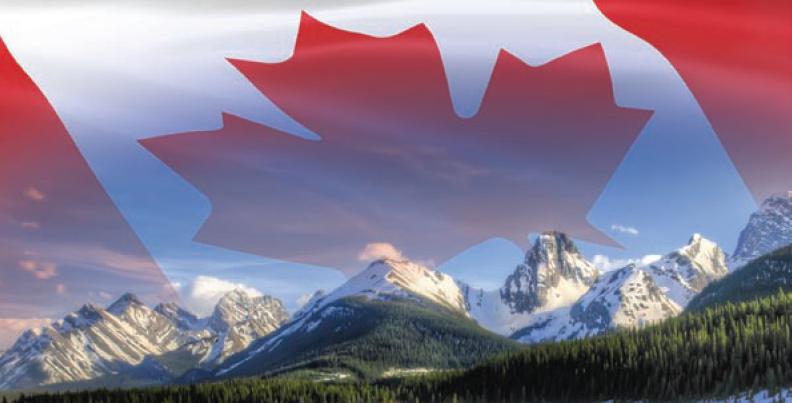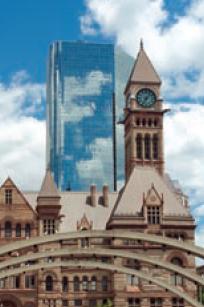Did you know that Canada takes up 2% of the planet Earth’s land surface? Yet it has one of the world’s lowest population densities at 9 people per square mile? It’s a land of wonderful and beautiful contradictions.

Another obscure fact is that the name Canada loosely translated means ‘village’. This demonstrates the nation’s gift for understatement. A giant country of endless plains and mountain ranges, it experiences wide variations in climate from perma-frost in the north to four distinct seasons towards the US border in the south. Most of its wilderness is impenetrable to man and is a biome full of diverse wildlife – famous for its bears and eagles. Some of the world’s widest and longest rivers, and biggest uninhabited islands are found there. With everything on such a large scale you may not be so surprised to learn that Canada is home to the longest street in the world - Yonge Street. This colossal road begins at Lake Ontario, and runs north through to the Minnesota border, a distance of almost 2000 km.
In recent years, Canada has introduced some of the world's most liber al social policies. Medical marijuana for the terminally or chronically ill was legalised in 2001; the country began legally dispensing marijuana by prescription in July 2003. In July 2005, Canada legalised gay marriage throughout the country, becoming one of four nations throughout the world to do so.
al social policies. Medical marijuana for the terminally or chronically ill was legalised in 2001; the country began legally dispensing marijuana by prescription in July 2003. In July 2005, Canada legalised gay marriage throughout the country, becoming one of four nations throughout the world to do so.
Canada is rather modest when it comes to its achievements in the world theatre of invention. However its contributions are all pretty amazing and enviable. For instance, basketball has its origins in Canada and it originally involved knocking birds off a wall with a football. Other inventions include the telephone, IMAX, television, piano synthesizers, the electron microscope, Trivial Pursuit and the zip fastener!
Famous Canucks include actors: Jim Carrey, Keanu Reeves, Leslie Nielsen, Michael J Fox, John Candy, Dan Aykroyd; singers / bands Alanis Morrisette, Avril Lavigne, Shania Twain, The Dream Warriors, Main Source, Neil Young and Leonard Cohen; filmmakers Atom Egoyan and David Cronenberg; and inventors Alexander Graham Bell and Reginald A. Fessenden. The national sport is lacrosse and not ice hockey as popularly thought. 
The country’s history is rich and interesting yet not terrifically well-known in the international psyche. In brief, prior to the arrival of Europeans in Canada, the area was inhabited by various peoples who came from Asia via the Bering Strait more than 10,000 years ago. The Vikings followed in Canada AD 1000. The first inhabitants of Canada were native Indian peoples, primarily the Inuit (Eskimo).
The first Europeans arrived in 1497, when John Cabot, an Italian in the service of Henry VII of England, reached Newfoundland or Nova Scotia. Canada was later taken for France in 1534. Because of the valuable fisheries and fur trade, a conflict developed between the French and English that eventually culminated in the Treaty of Paris in 1763 which gave England control. However, Canada continued to be fought over steadily throughout the 17th – 19th century by both countries. In 1849, the right of Canada to self-government was recognised. By 1905 most of today’s provinces and territories were born.
To this day, Canada remains one of the most sought after countries to live in for people around the world. Up to the 1970s most of the immigration was from Europe but for the last two decades the major immigration has come from China, the Indian sub-continent and the Philippines. A richly liberal country, it has been called home for many world citizens for decades and will remain a beacon of civilization for some time to come.
The Mover thanks Brian Taylor of Brytor International Moving for his help with this article.
Photos: Calgary, Toronto.
A Sporting Life
 Canadians are the gods of winter sports. With a huge national and government endorsed emphasis on having a sporting life a huge proportion of Canucks indulge, big time.
Canadians are the gods of winter sports. With a huge national and government endorsed emphasis on having a sporting life a huge proportion of Canucks indulge, big time.
Although the average non-Canadian would hazard a guess at ice hockey (simply known as hockey) being the national sport it is in fact lacrosse, a sport with Native American origins. However hockey is the most popular spectator sport by a long shot.
The national sport with the second largest following is Canadian football (a version of gridiron football) with the league’s annual championship ‘The Grey Cup’ being the largest annual event.
A little known fact is that basketball was invented in Canada too. In broadest terms it was originally developed by school boys knocking birds off a wall with a football. Statistics Canada reports that the top ten sports that Canadians participate in are golf, ice hockey, swimming, soccer, basketball, baseball, volleyball, skiing (downhill and alpine), cycling and tennis.
Canada's 2014 immigration plan to 'drive economic growth'
In Autumn 2013, the immigration minister for Canada, Chris Alexander announced new measures for border control in 2014.
Mr Alexander announced that he intended to maintain total immigration numbers between 240.000 and 265,000 for the coming year. Of these, 63% will be economic (skilled) migrants. The remaining 37% will be admitted under the family or humanitarian stream.
Mr Alexander announced that two existing visa programmes will be significantly expanded: the Canadian Experience Class (CEC) and the Provincial Nominee Program (PNP).
The CEC enables immigrants who have been working in a skilled or managerial position in Canada for over 12 months to apply for a permanent resident visa. The PNP was designed to encourage immigrants to settle outside Canada's main population centres in Toronto, Montreal and Vancouver.
All of Canada's provinces and territories have signed up to the PNP apart from Quebec, which has its own immigration programmes and Nunavut, the newest of Canada's territories, which was created as a homeland for indigenous Inuit people of northern Canada in 1999.
Canada - the land of abundant snow
 Canada has always been a major destination for immigrants from Britain and this was the market that Brytor International Moving aimed for when starting in 1964. As the company enters its 50th year, Brian Jones, looks at the challenges of working in the Canadian winter.
Canada has always been a major destination for immigrants from Britain and this was the market that Brytor International Moving aimed for when starting in 1964. As the company enters its 50th year, Brian Jones, looks at the challenges of working in the Canadian winter.
I joined the company as Executive Vice-President in 2009, having previously lived and worked in the UK for Michael Gerson Limited. It was a great opportunity to experience life in a new country. The sheer size of the country does take some getting used to, with a five hour flight to reach our Vancouver office. I quickly learnt that the wilderness here really is wild – as the Canadians famously say ‘if you can’t see a Tim Hortons Coffee Shop, you shouldn’t be there!’ I love it here but there are some very valid and challenging aspects to operating a moving firm in Canada.
In Canada there’s no escaping the gigantic scale of the country and its extreme climates. These factors impact on all aspects of daily life. As far as Brytor is concerned it is always prepared for snowy weather and that is crucial to keeping the company running throughout the four months of winter temperatures. Each office has its own snow plough that keeps the site roadways and yards clear. As snow gets ploughed to the side of the yard it builds into banks, a further contingency plan to have this snow moved with a JCB and stacked up to leave the maximum workable space in the yard. This can get to a stage where it is too high for a JCB to handle. In instances like this a snow removal contractor is called in to truck the snow off site.
Brytor’s fleet of trucks have engine block heaters that are left plugged in overnight to ensure we are ready to go in the morning. Not surprisingly we also have to fully heat our warehouse which is maintained at 15°c. This has a significant impact on running costs compared with a similar operation in a warmer country. Cold temperatures also provide difficult conditions for our packing crews, particularly on loading day where they will often be walking in and out of a home with temperatures indoors of 20°C to an outside temperature of -15°C.
 Winter does not stop the moving business and even with heavy snowfalls the roads are quickly ploughed with the use of snow ploughs in remoter locations. In the relative safety of Southern Ontario even well-seasoned professionals can still get caught out. In a bad snow storm in 2010 we lost a vehicle and trailer that had been blown off an icy road in strong cross winds. Fortunately the driver was OK and the container was empty and on its way to be loaded – however the tractor unit was written off.
Winter does not stop the moving business and even with heavy snowfalls the roads are quickly ploughed with the use of snow ploughs in remoter locations. In the relative safety of Southern Ontario even well-seasoned professionals can still get caught out. In a bad snow storm in 2010 we lost a vehicle and trailer that had been blown off an icy road in strong cross winds. Fortunately the driver was OK and the container was empty and on its way to be loaded – however the tractor unit was written off.
One of my early impressions of Canadian life came about with an early-morning traffic update. Orillia, a town about 1½ hours drive north of Toronto had been brought to a standstill due to two Brown Bears wandering around downtown. I was amazed but apparently it’s just your slightly above average Tuesday morning in these parts.
On another occasion, I had to attend customs to clear a shipment on behalf of a customer. Arriving at the customs office I was not aware that our import manager had kindly arranged for customs to ‘set me up!’ Customs staff proceeded to get me to answer questions on the Canadian constitution, Canadian History and finally sing the national anthem. Fortunately they took pity on me and I survived unscathed – revenge pending.
I don’t have rose-tinted spectacles, you will need to work as hard here as anywhere else, but working with Brytor and living in Canada is a great place to be.
Photo: Brian Jones
Canadian Customs
AMJ Campbell’s Senior Vice-President, Kevan Brown speaks about recent changes to Canadian border controls concerning the collection of freight. A huge part of AMJ Campbell’s workload is made up of managing international freight and Kevan has noticed a shift in the way port operations operate recently.
“A growing pain AMJ Campbell and no doubt other companies would have been experiencing recently has had to do with the port operations here in Canada,” explained Kevan. “There is a new rule that requires the carrier to book an appointment prior to picking containers up. I suppose this has been introduced to streamline the flow of traffic and to manage staffing levels at the ports. This practise has taken some getting used to, because once the limited appointments have been allotted for the day, and you’ve not been lucky enough to get one, there is a need to wait until the following day and so on. This of course can have a ‘knock-on’ effect causing unwanted delays. However AMJ Campbell has been working closely with its local carrier to reduce issues to a minimum. Our counter-measures ought to reduce negative incidents drastically.”
Since 2008, the Canada Border Services Agency (CBSA) requires that all shippers declare their goods at time of their arrival at the airport, providing a list of the goods to follow with values (taking into account depreciation) in Canadian dollars. If required, the B4E document* is to be issued by customs. Once the goods arrive in Canada and are ready for customs clearance, the shipper/consignee will need to present themselves to a CBSA office. As a removals company, AMJ Campbell or any other company cannot attend or clear goods on the behalf of a customer, although if necessary, a customs broker can be hired to complete the task for them.
AMJ Campbell claims to be Canada’s largest moving company with 44 offices across the entire country. It was formed back in 1983 in Vancouver and expanded across to the eastern seaboard by 1995 after a series of buy outs and mergers.
*B4E: Personal Effects Accounting Document
Happy 75th Birthday to Highland Moving & Storage
 The folks at Canada’s Highland Moving & Storage had a recent celebration in honour of its 75th year in the moving business. By Sylvia Cieslik
The folks at Canada’s Highland Moving & Storage had a recent celebration in honour of its 75th year in the moving business. By Sylvia Cieslik
As the company was first established in 1938, the timing was perfect to pay tribute to the family-owned business.
Highland Moving & Storage first started out known as ‘Jim’s Express Transfer and Baggage Hauling Ltd.’ Popular legend around the office would have it that company founder Peter Kachur kept the name ‘Jim’s Express’ because he did not have enough paint to cover the writing on the truck doors from the previous owners. However what Peter did have, was a strong and enduring nose for business which he applied generously, allowing his moving company to grow. After some time, the business was renamed Highland Moving & Storage.
On the evening of Saturday November 23, 2013, almost 150 Highland employees from both the Edmonton and Calgary branches gathered together to celebrate the company anniversary. In honour of the occasion, a custom cake was made in the shape of a Highland moving truck complete with headlights that glowed throughout the evening.
Don Kachur, president of Highland Moving and son of company founder, believes its success in the moving industry is down to its integrity. “If you’re going to stay in our business for 75 years, you’d better be good at what you do,” he said during his celebratory speech. Over the course of the speech, Don thanked all of his employees for all their hard work in making Highland a great moving company to work for. He highlighted that Highland is a customer-service driven business and that without its experienced crews, customer service departments, marketing team and management group, Highland would not be a successful industry contender.
The congratulatory speech was followed by an awards ceremony, cutting of the Highland truck cake and a thoroughly enjoyable evening filled with music and dancing. All in all, a memorable night was had by everybody. Here’s to another successful 75 years and beyond.
Congratulations Highland Moving on your 75th Anniversary.
Photo: The cake cutting: L-R: Casey Kachur, Kelti Kachur, Torah Kachur and Don Kachu
Click here to see the next Editor's pick